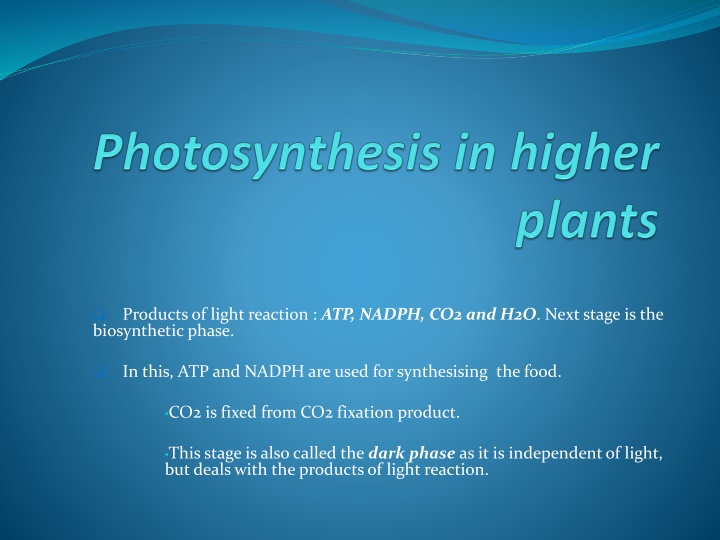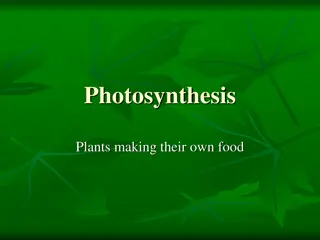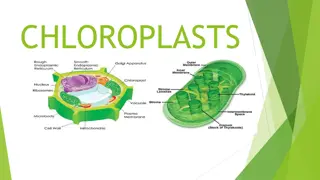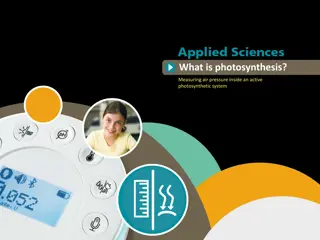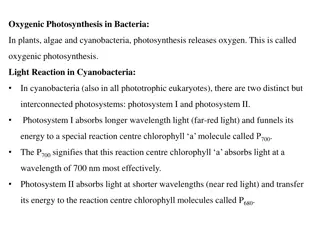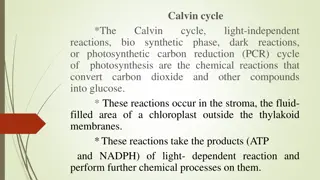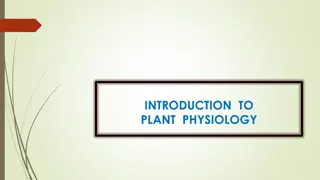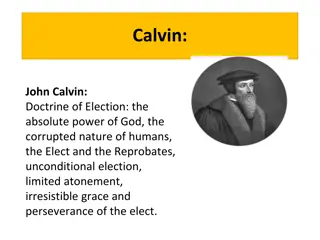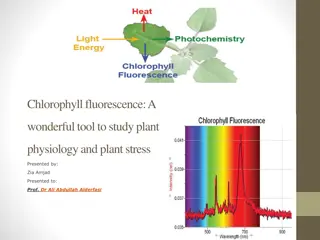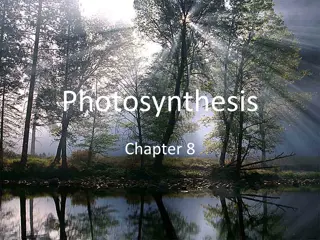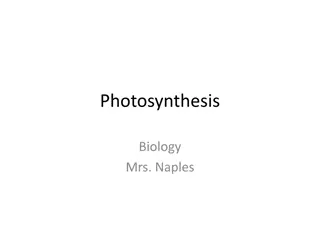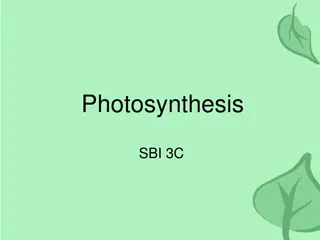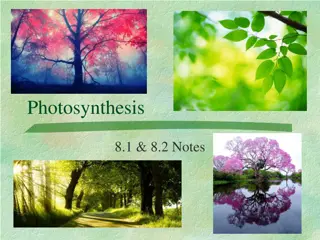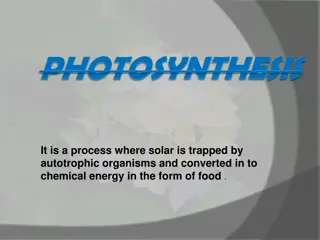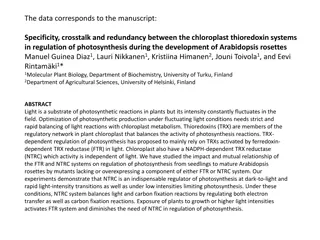Photosynthesis: ATP, NADPH, Calvin Cycle, and Plant Pathways
In the biosynthetic phase of photosynthesis, ATP, NADPH, CO2, and H2O are utilized in the production of food through the Calvin Cycle. The cycle occurs in the stroma of chloroplasts and includes carboxylation, reduction, and regeneration stages. Plants can follow either the C3 or C4 pathway, with distinct initial fixation products. The Calvin Cycle is essential for all photosynthetic plants, independent of their pathway. Explore the intricate process of capturing and converting light energy into organic compounds for plant growth.
Download Presentation

Please find below an Image/Link to download the presentation.
The content on the website is provided AS IS for your information and personal use only. It may not be sold, licensed, or shared on other websites without obtaining consent from the author.If you encounter any issues during the download, it is possible that the publisher has removed the file from their server.
You are allowed to download the files provided on this website for personal or commercial use, subject to the condition that they are used lawfully. All files are the property of their respective owners.
The content on the website is provided AS IS for your information and personal use only. It may not be sold, licensed, or shared on other websites without obtaining consent from the author.
E N D
Presentation Transcript
biosynthetic phase. Products of light reaction : ATP, NADPH, CO2 and H2O. Next stage is the In this, ATP and NADPH are used for synthesising the food. CO2 is fixed from CO2 fixation product. This stage is also called the dark phase as it is independent of light, but deals with the products of light reaction.
The reaction involved in the biosynthetic phase takes place in the Stroma of Chloroplast.
In some plants, the first product of co2 fixation is a 3-carbon compound called 3- phosphoglycericacid (PGA). These plants are said to adopt the c3 pathway. For example : Rice , Wheat, etc. These plants are the most common and most efficient at photosynthesis in cool, wet climates. In other plants, the first co2 fixation product is a 4-carbon compound called oxaloaceticacid . These plants are said to adopt the c4 pathway. For example: Maize , Sugarcane, etc. These plants are most efficient at photosynthesis in hot, sunny climates.
6x of co2 6x 6C unstable compound 6x Ribulose Bisphosphate (RUBP) 6 ADP 6 ATP 12x 3 Phosphoglyceric Acid Calvin Cycle (C3 Cycle) Ribulose Monophosphate 12 ATP 12 ADP 12x 1,3 Diphosphoglyceric Acid 10x Glyceraldehyde 12 NADPH2 12 NADP 3 Phosphoglyceraldehyde 2x Glyceraldehyde Phosphate Glucose
Calvin cycle occurs in all photosynthetic plants, irrespective of weather they have C3 or C4 pathway. The primary acceptor of co2 was found to be a 5-carbon ketose sugar called Ribulose bisphosphate (RuBP). This was surprising as it was believed that the formation of a 3-carbon product, co2 would have to be accepted by a 2-carbon compound. RuBP is used in cyclic manner(regenerated) and a sugar is synthesised.
3 stages of Calvin Cycle : Carboxylation, Reduction and Regeneration. Carboxylation: It is the first of Calvin cycle where three molecules of RuBP (5C) reacts with three molecules of CO2 (1c) and forms (6c) unstable compound in the presence of enzyme RuBP Carboxylase (Rubisco). This 6c unstable compound at once breaks into 6 molecules of 3- phosphoglyceric acid (PGA) with the help of an enzyme RuBP Carboxylase.
Reduction: The 6 molecules of 3-phosphoglyceric acid (3c) are phosphorylated to 6 molecules of 1,3 diphosphoglyceric acid by utilising 6 ATP molecules. The enzyme Kinase catalyses this reaction. The 6 molecules of 1,3-diphosphoglyceric acid (3c) are reduced to 6 molecules of glyceraldehyde phosphate (3c) utilising NADPH2 supplied by light reaction (PS- 2). The enzyme dehydrogenase catalyses this reaction. Thus, glycolytic reversal regenerates ADP and NADP required for light reaction.
Regeneration of RuBP: The regeneration of RuBP requires the utilisation of 5 molecules of glyceraldehyde phosphate and 3 molecules of ATP. There is regeneration of RuBP for maintaining the continuity of Calvin cycle. The one molecule of glyceraldehyde phosphate forms the glucose and other sugars. This step is essential to maintain the continuity of Calvin cycle for fixation of fresh supply of CO2.
Thus, to synthesize one molecule of glucose, the 6 turns of dark reaction cycles are required. For every CO2 molecules entering the Calvin cycle, 3 molecules of ATP and 2 of NADPH are required. So, to make one molecule of glucose, 18 ATP and 12 NADPH are needed.
C4 pathway (Hatch and slack pathway) Occurs in plants like maize, sugarcane- plants adapted to dry tropical regions. The leaves of C4 plants have Kranz Anatomy. They have special large cells around their vascular bundles called Bundle Shealth cells. These cells form several layers around the vascular bundles and have large number of chloroplasts, thick walls impermeable to gaseous exchange, and lack intercellular spaces. First CO2 fixation product is a 4-carbon compound called Oxaloacetic Acid, but C3 cycle is used as the main biosynthetic phase.
Mesophyll cells: Occur in the C4 cycle. Bundle Sheath cells: Occur in the C3 cycle. C4 plants can tolerate high temperature and high light intensity, show greator productivity of biomass, and lack photorespiration.
Primary CO2 acceptor: Phosphoenol pyruvic acid (PEP) a 3-carbon molecule. Phosphoenol pyruvic acid(3c) combines with carbon-di-oxide in the presence of enzyme PEP Carboxylase and yields Oxaloacetic acid (4- carbon dicarboxylic acid). Oxalo acetic acid is reduced to malic acid (4c) and later aspartic acid in the presence of NADPH2 and ATP. NADPH2 of PS-2 supplies electrons. Aspartic acid is then transported to chloroplast of bundle shealt cells through plasmadesmata. In the bundle sheath, the aspartic acid is decarboxylated to pyruvic acid by aspartic enzyme. The CO2 combines with RuBP of the chloroplast to complete the Calvin cycle.
Pyruvic acid is then exported to the chloroplast of the mesophyll cells where it is phosphorylated to generate PEP by pyruvic dikinase. Here 2 ATP molecules are utilised. In these plants, the CO2 fixation undergoes through the processes of Calvin cycle as well as by Hatch and Slack pathway. The additional process of CO2 fixation through Hatch and Slack pathway. The additional amount of CO2 fixation through Hatch and Slack pathway requires extra amount of 12 ATPs. C3 cycle cannot directly occur in the mesophyll cells of C4 plants because of the lack of the enzyme RuBisCO in these cells. RuBis CO is found in abundance in the bundle sheath cells of the C4 plants. They lack PEPcase.
